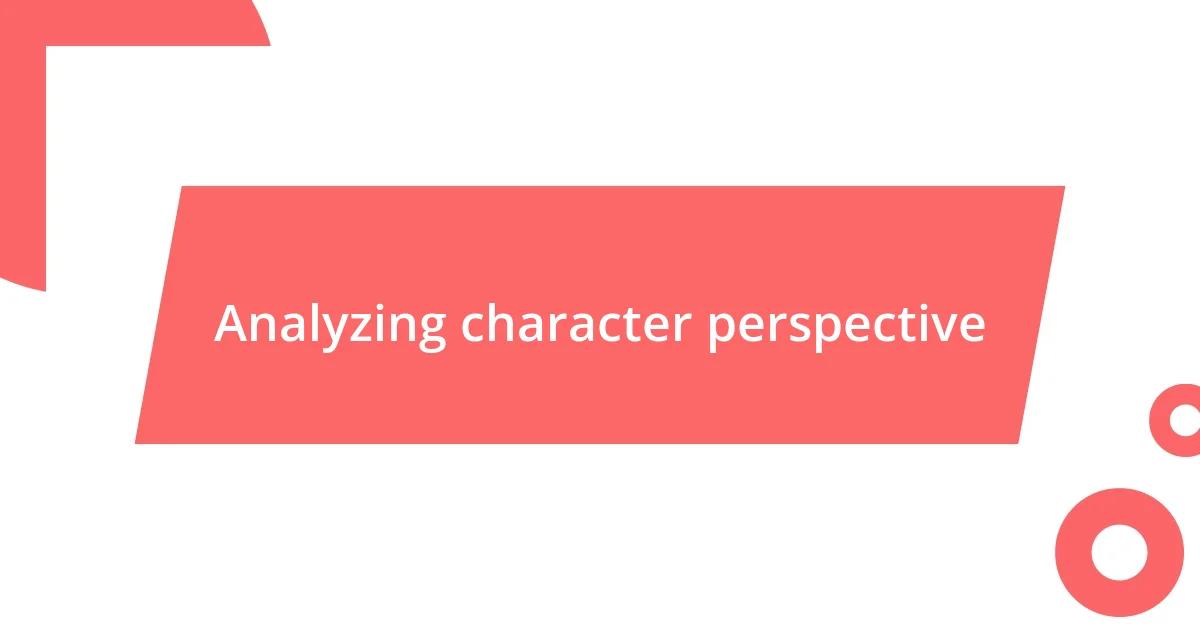Key takeaways:
- Narrative choices, including perspective, setting, and character development, significantly impact storytelling by shaping reader engagement and emotional connections.
- Different narrative structures, such as linear, non-linear, frame narratives, and episodic formats, each offer unique ways to convey stories and enhance thematic depth.
- Practical exercises like rewriting stories from new perspectives, character diaries, and using visual prompts can deepen understanding and exploration of narrative techniques.

Understanding narrative choices
Understanding narrative choices is essential for any storyteller. When I reflect on my own writing journey, I realize how the choice of perspective can drastically change a story. Have you ever considered how a first-person point of view invites readers into the narrator’s intimate thoughts, while a third-person omniscient perspective can allow for a broader understanding of all characters? It’s a fascinating dance between connection and distance.
In my experience, the setting can also serve as a powerful narrative choice. There was a time when I set a story in a bustling city. The backdrop influenced not just the plot, but also the mood. The vibrant energy of the streets echoed the characters’ emotions, almost like they were in a dialogue with their surroundings. How can a simple choice of location deepen the reader’s emotional engagement with the narrative? It’s something I continually marvel at.
Characters are the backbone of any narrative, and their development hinges on intentional choices. I recall crafting a complex antagonist who, at first glance, seemed purely evil. But delving into their backstory revealed layers of pain and regret. This decision not only enriched my story but also made readers question their judgments. How often do we dismiss characters without understanding their journeys? This layering invites readers to explore the gray areas of morality and empathy, enriching their experience.

Importance of narrative in storytelling
Narrative is at the heart of storytelling; it shapes how audience perceives characters, events, and themes. On a personal note, I’ve always found that a well-crafted narrative pulls readers into a world where they almost feel as though they are living the experiences alongside the characters. There was a time when I wrote a short story where the main character faced a moral dilemma, and the specific choices I made in how the narrative unfolded truly defined the emotional gravity of that moment. Readers often told me that they felt torn as if they were the ones making the decisions.
- It creates emotional connections: A gripping narrative allows the audience to empathize with characters.
- It shapes perspective: Different narrative structures can significantly alter a reader’s interpretation of events.
- It drives engagement: A compelling narrative keeps readers invested in the outcome and the characters’ journeys.
- It influences tone and mood: Choices in narrative can set the atmosphere, transforming an ordinary scene into something profound.

Types of narrative structures
Different narrative structures shape stories in unique ways, and understanding them enriches the storytelling process. For instance, a linear structure progresses in a straightforward sequence, allowing readers to follow the story chronologically. In contrast, a non-linear structure tantalizes with jumps in time, often creating suspense. I remember experimenting with this in a short story I wrote, where the non-linear approach revealed character motivations more dramatically, as readers slowly pieced together the timeline.
Another popular structure is the frame narrative. This approach involves a story within a story, which can add layers of complexity. I once crafted a story where a grandmother recounts her youth, weaving her experiences with her granddaughter’s present struggles. This not only deepened the emotional stakes but also allowed for a rich exploration of generational themes. It’s amazing how such structures can create multiple dimensions of understanding, inviting readers to reflect on their own experiences alongside the characters.
Finally, the episodic structure, consisting of a series of loosely connected moments, can offer delightful variety. When I wrote a series of vignettes, each capturing a different season in a character’s life, I was pleasantly surprised by how each moment resonated independently yet cumulatively formed a rich tapestry of growth and change. This flexibility of structure can lead readers to engage on different levels and discover personal meaning in seemingly disconnected events.
| Type of Narrative Structure | Description |
|---|---|
| Linear | Progresses chronologically with no significant jumps in time. |
| Non-linear | Jumps around in time, revealing events out of order for suspense. |
| Frame narrative | A story within a story, adding layers of meaning and context. |
| Episodic | Consists of loosely connected moments or vignettes that form a larger picture. |

Techniques for exploring narrative choices
Exploring narrative choices can be deeply satisfying, especially when employing various techniques like character perspective shifts. I recall a story where I switched between first-person and third-person perspectives. This technique not only allowed readers to intimately experience a character’s thoughts but also presented an objective view of the events, creating a delightful tension. Isn’t it fascinating how altering a narrator’s viewpoint can fundamentally change the emotional landscape of a story?
Another technique that I’ve found immensely rewarding is the use of unreliable narrators. I once penned a piece featuring a protagonist who carefully curated their story to manipulate the reader’s perception. The moment the truth was revealed, it left readers in a state of disorientation and surprise, prompting them to reevaluate everything they thought they understood. Have you ever experienced that shock of realization that makes you want to go back and reread an entire book, piecing together the clues?
Lastly, experimenting with pacing is a technique that can transform narrative choices remarkably. In a recent short story, I intentionally slowed down key moments to intensify suspense and heighten emotions. By drawing out a character’s internal struggles, I created a palpable tension that made the eventual resolution all the more satisfying. It made me wonder, how often do we overlook the power of pacing in our own writing journeys?

Analyzing character perspective
When I analyze character perspective, I often reflect on how a character’s background influences their worldview. For instance, in one of my stories, my protagonist grew up in an impoverished neighborhood, which shaped her understanding of trust and friendship. This perspective allowed me to delve into her internal conflicts about risking relationships, making her journey all the more compelling.
One technique I particularly enjoy using is playing with different perspectives within a single narrative. In a recent project, I narrated each chapter from the viewpoint of a different character, allowing them to share their unique struggles and motivations. It was fascinating to see how one event could be interpreted so differently depending on the character’s lens. Have you ever noticed how your perception shifts when you try to view a situation through someone else’s eyes? It really drives home the idea that every person has a story worth telling.
Moreover, I find that a character’s emotional state can heavily sway their perspective. In writing a character grappling with grief, I chose to depict their reality through a foggy, dreamlike lens. This approach mirrored their confusion and sense of loss, allowing readers to deeply empathize with their pain. Authentic emotion can enhance a narrative, making us ponder how our own experiences shape our perception of the world. Isn’t it incredible how much we can learn about ourselves through the characters we create?

Impact of setting on narrative
Setting plays an essential role in shaping a narrative. I remember crafting a story set in a desolate, post-apocalyptic world. The bleakness of the environment not only reflected my characters’ inner struggles but also heightened the tension and urgency of their journey. Can you think of a moment in a book where the setting felt almost like a character itself?
When I think about the impact of setting, I often recall a scene I wrote in a vibrant, bustling cityscape. The frenetic pace of life and diverse interactions mirrored my protagonist’s chaotic emotional state. It was a deliberate choice to create a backdrop that echoed her turmoil, and I felt that it deepened the reader’s understanding of her struggles. Have you noticed how a well-constructed setting can evoke emotions you didn’t even realize were lurking beneath the surface?
I’ve also experimented with historical settings to ground my narratives in authenticity. In one of my pieces set during the 1920s, I immersed myself in the era’s culture and language, allowing me to weave in rich details that transported readers back in time. This choice not only added depth but also made readers reflect on how historical contexts shape personal stories. Isn’t it amazing how setting can merge with character and plot to create a more layered experience?

Practical exercises for narrative exploration
One exercise I often recommend for narrative exploration is rewriting a familiar story from an unexpected point of view. For example, I once decided to tell “Little Red Riding Hood” from the perspective of the wolf. This shift not only made me rethink the traditional villain’s role, but it also allowed me to explore themes of misunderstanding and redemption. Have you ever considered how a simple perspective shift can completely change the narrative?
Another technique involves crafting a detailed character diary. I remember when I wrote a diary entry from my protagonist’s perspective after a significant event. This exercise deepened my understanding of her emotional turmoil and provided insight into her thought processes. As I poured her feelings onto the page, I found myself more connected to her journey. Have you tried writing in your character’s voice? It’s a powerful way to uncover hidden layers of their personality.
Finally, I love using visual prompts to spark narrative ideas. One time, an eerie photograph inspired me to create a suspenseful scene. As I examined the image, I began asking questions: Who lived here? What secrets did these walls hold? This approach not only kicked off a captivating story but also helped me to visualize the setting vividly. Have you ever used imagery to ignite your imagination? It’s an exhilarating way to breathe life into your narratives.















